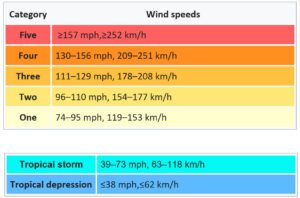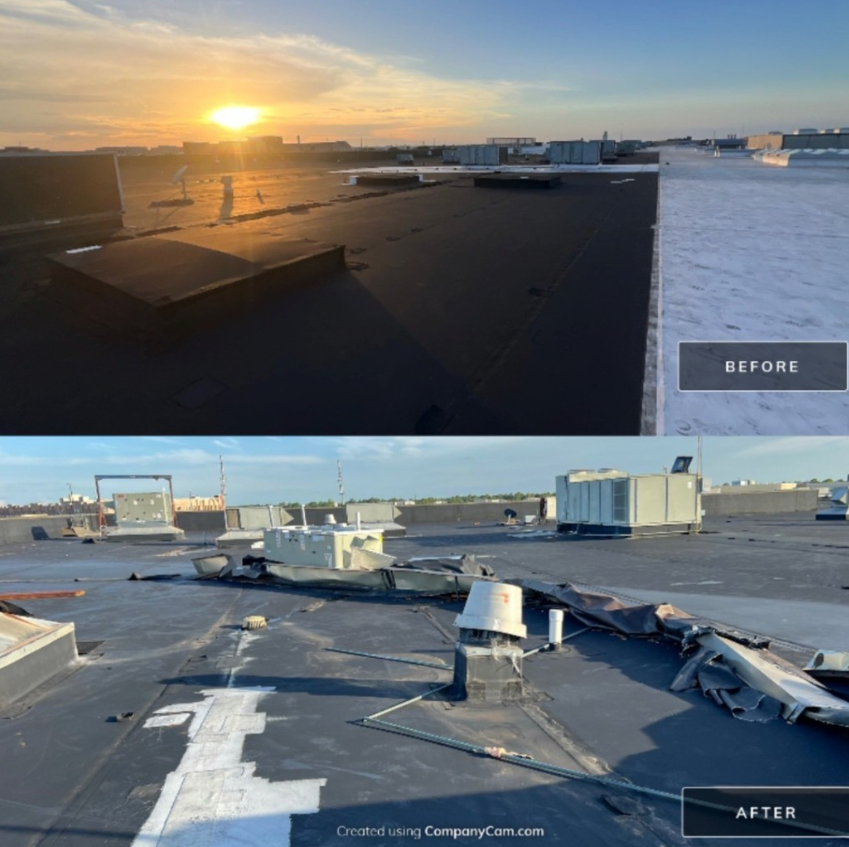Roofing Ratings and Resistance
Rated class 2 impact resistant. Class H wind resistant. Those all sound great! But what does that actually mean? Are these made up metrics to sound fancy? You’ll be happy to learn that they’re not! These classifications are scientific and actually give you real information about your roof. So today we’re going to go through roofing ratings and resistance so you know what you’re reading when you research your roofing needs. Roof Experts has first hand experience with hurricane force winds and the damage they can do, with and without debris.

Commercial roof damage sustained by one of our clients due to Hurricane Beryl 2024.
What Are Roof Rating Systems?
Lucky for us, there are standardized methods of rating roof materials- it’s not just manufacturer mumbo jumbo. We’re going to go through the main ones and what you should look for given your area. Are you prone to hurricanes? Tornadoes? Hail or snow? It’s important to choose the right materials or at least know when your roof may experience damage. These roofing rating systems evaluate the durability and performance of various roofing materials by simulating extreme weather conditions. So which ones are most used?
FM Global RoofNav: (stay with us, the other ones aren’t as complex)
- This rating system takes into account the American Society of Civil Engineers article entitled “Minimum Design Loads for Buildings and Other Structures.” The rating process here is fairly complicated but here are some of the alphanumerical ratings you may see.
- 1- represents that the roof assembly has passed a standardized interior fire test; often the first number you see.
- 180- the second number represents the wind performance rating in pounds per square foot; note, this is pressure, not wind speed!
- A- the exterior fire rating. For more on this topic, check this out.
- H/ SH- describes whether it is rated for hail or severe hail.
- This rating system takes into account the American Society of Civil Engineers article entitled “Minimum Design Loads for Buildings and Other Structures.” The rating process here is fairly complicated but here are some of the alphanumerical ratings you may see.
Underwriters Laboratories (UL) 2218 Impact Resistance:
- UL developed a much more digestible testing method for impact resistance than FM. UL rates roofing materials from class 1-4 by dropping steel balls of varying sizes from varying heights. If the material does not show signs of cracking or tearing, it has successfully passed the rating test.
- Class 1: 1.25″ diameter steel ball dropped from 12 ft.
- Class 2: 1.5″ diameter steel ball dropped from 14 ft.
- Class 3: 1.75″ diameter steel ball dropped from 17 ft.
- Class 4: 2″ diameter steel ball dropped from 20 ft.
- Pay close attention to this if you live in a hail-prone area! Roof Experts can help you decide what material is best for your new roof.
- UL developed a much more digestible testing method for impact resistance than FM. UL rates roofing materials from class 1-4 by dropping steel balls of varying sizes from varying heights. If the material does not show signs of cracking or tearing, it has successfully passed the rating test.
American Society for Testing and Materials (ASTM) D3161 and D7158:
- Don’t worry, this sounds wild but it isn’t. These two tests analyze wind resistance for roofing materials. The former takes a look at speeds up to 110 mph and the latter covers speeds of up to 150 mph. Here’s a graph of hurricane wind speeds in case you’re not sure which effects you most.

Live a little inland? You may not have to consider wind speeds of up to 150 mph as much as your coastal friends.
What Roof Ratings You Should Look For
Assuming you are a Texan or a friendly neighbor, here are some of the factors you should consider:
Wind resistance:
- Your wind resistance ratings should at LEAST meet ASTM D3161 or D7158 standards. In an ideal situation, they exceed these ratings so that your roof can hold tight during a storm.
Impact resistance:
- While hurricane force winds are highly damaging, the debris they can throw can be even worst. Look for a UL Class 4 rating to withstand even the most extreme weather.
Water resistance:
- Ensure the roofing material and its installation technique provides top-notch water resistance. With Roof Experts, you don’t have to worry. We are big advocates of Securock and skillful TPO installation.
Durability:
- Keep in mind the durability of your roofing system. Is it made to last in your area? The three little pigs can tell you that not all building materials are created equally. Remember that choosing the most economical option may not be economical in the long run if it ends up needing replacement after only a few years of harsh conditions.
Roof Ratings Notes and Conclusion
Remember that your roof rating doesn’t mean much if your roofing system isn’t installed by a professional with knowledge and precision. Roof Experts is here to guide you to find the right roof and to make sense of the various roof rating systems so that you are sure to get what you need. Make sure your roof can withstand the wind, rain, and impacts of the weather in your area.
Give us a call with all of your roofing needs! And be sure to follow along on social media for helpful hints and the perfect dose of silliness!
Roof Experts is here to inspect any commercial or residential roof you need. Contact us today and let us know what we can do for you!
View this profile on Instagram


